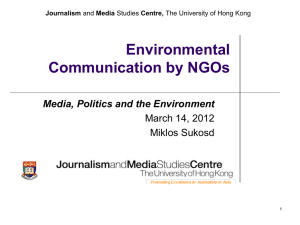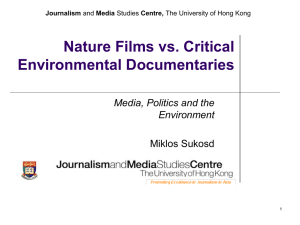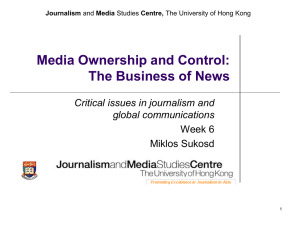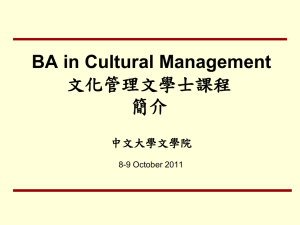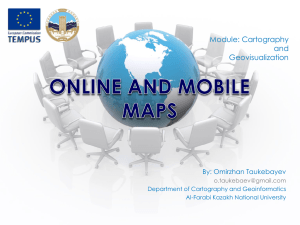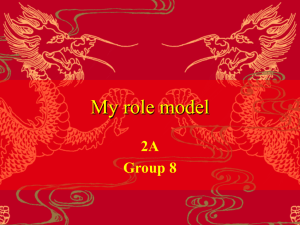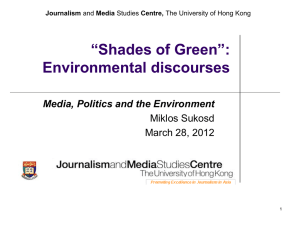Lecture Slides 6. Fiction films and the environment
advertisement
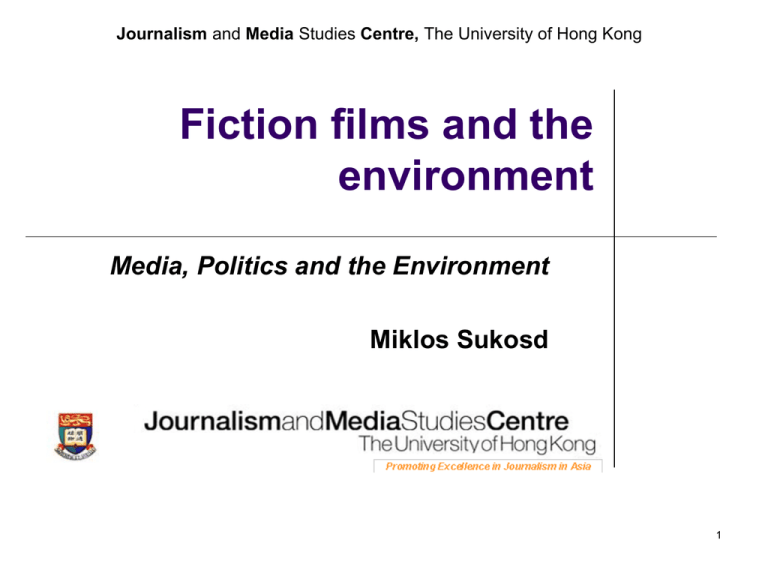
Journalism and Media Studies Centre, The University of Hong Kong Fiction films and the environment Media, Politics and the Environment Miklos Sukosd 1 Journalism and Media Studies Centre, The University of Hong Kong Structure of presentation and discussion Introduction Representation of nature in film Eco-cinema and eco-criticism Eco-cinema in Hollywood Eco-cinema in China Environmentalism and movie stars What can activists and journalists do? Cases: movies with environmental content 2 Journalism and Media Studies Centre, The University of Hong Kong Introduction •Fiction films: an art form vs. mass media (objectivity and advocacy based on facts) •Narrative and characters are fictional vs. documentaries (also an art form, but based on facts) •Artistic freedom, complex artistic presentation (including story/screen-play, directing, camera, actors, cuts, lighting) •Genres include fantasy, drama, tragedy, tragicomedy, comedy, crime story, science fiction •Emotions (love against odds, betrayal, friendship, growing up, parents and children, getting old/sick, adventures) •Gender roles reflected and shaped by cinematic representation •Durable cultural expression of identities (ethnic minority, sexual, linguistic, religious) 3 Journalism and Media Studies Centre, The University of Hong Kong • • • • • • • • Fiction films: art form vs. commercial product (“high” vs. “mass” or popular culture) European vs. American traditions of filmmaking Art form: de-familiarization, novel techniques (e.g., cuts), symbolism, allegory (China: water or a “backward” village) Expressing (and overcoming) social and cultural trauma: colonialism, disasters, migration, intercultural encounters Popular culture: entertainment, expressing mainstream value preferences and perpetuate values changes Popular archetypes and myths (beast from King Kong, blonde from Marilyn Monroe, etc.) Film occupies a central part in cultural production in modernity Contemporary “cultural studies” and “media studies” are to a large degree films studies and studies of popular culture 4 Journalism and Media Studies Centre, The University of Hong Kong Representation of nature in film Critical aspects of modernization: human and ecological price Fiction: from subjugation of nature (e.g., hunting) to nature as utopia of just and sustainable society Harmonious cohabitation of humans and animals from Tarzan to Avatar (including dangerous animals) Ecological consciousness in films? Intended vs. non-intended environmental content? Environmental themes central vs. not central in the plot/visuals? Roles of journalists to cover fiction films with environmental content? 5 Journalism and Media Studies Centre, The University of Hong Kong Eco-criticism and eco-cinema Ecocriticism in literature: “ecocriticism is the study of the relationship between literature and the physical environment” (Cherill Glotfelty, The Ecocriticism Reader, 1996, xviii) In the age of environmental crisis, theory of art cannot be blind to ecological matters “Films criticism ought to be a major constituent of ecocriticism. In the simplest terms, ecocinema is cinema with an ecological consciousness.” (Sheldon H. Lu: Chinese Ecocinema in the Age of Environmental Challenge, 2009, 2) Eco-cinema: filmmaking and interpretation/criticism Eco-cinema: both fiction and documentaries 6 Journalism and Media Studies Centre, The University of Hong Kong Eco-cinema in Hollywood Sylvester Stallone plan: Rambo against environmental criminals: Karen Hirsch Greenpeace coordinator responds with horror (movie never materialized) “The issues are complicated, they’re not supposed to be black and white” (Green Screen, p. 1) Environmental hazards (ozone depletion, global warming, nuclear radiation, toxic pollution) complex issues Individual and collective responsibility NO simple, fast, individual solutions 7 Journalism and Media Studies Centre, The University of Hong Kong Eco-cinema in Hollywood Hollywood aesthetic strategies may be inadequate? Environmentalist criticism of Hollywood Lack of correspondence to real world, dissatisfaction Melodrama: art form” that seeks dramatic revelation of moral and emotional truths through a dialectic of pathos and action” Linda Williams (Green Screen, 2) 1. Melodrama individualizes environmental issues (villains vs. heroes: a Manichen worldview for blame and responsibility) [On Deadly Ground, Steven Seagal] 2. The hero solves problem by decisive action, one major act 3. American mythological patterns: from religion (savior, dualism of God and Evil; hell and paradise) to popular culture [Terminator 1-3, A. Schwarzenegger], individual solution 8 Journalism and Media Studies Centre, The University of Hong Kong Eco-cinema in Hollywood From 1980s: nature movies with morally innocent communities (native Americans, aborigines, Neanderthals, children, women, animals, healers, natural wonders) [Avatar] Villains: hunters; big business, property developer, nuclear plant, oil tycoon (bulldozer as representative) “Us vs. Them” – depolitization? Responsibility of humanity as a whole? Audience translation to real life? Reviewer: “desymbolizing” environmental issues to action Individual character + supporting crowd, public opinion? Functions of happy end? 9 Journalism and Media Studies Centre, The University of Hong Kong Ecocinema in China Social-economic context: voluntarism “victory over nature” under Mao from 1950s, Forced industrialization and economism since 1980s, unparalelled in world history Film examples: pollution of rivers (water in general), drought, dams vs symbolism of water as renewal, balanced society, tradition (bath), opening to the world (ocean) 10 Journalism and Media Studies Centre, The University of Hong Kong Major themes and subjects in Chinese eco-cinema “How the lives of ordinary people are affected by the destruction of nature and environmental degradation in the rentless processes of revolution, modernization and industrialization.” “The effects of urban planning, demolition, and relocation on the lives of ordinary residents. The fate of migrants in the city. “The relationship between humans and animals”, including antipoaching in Tibet; story of panda and trainer over many years. “Projection and description of an organic communal mode of life distinct from the daily routines of civilized daily folks.” Focus on ethnic minorities, remote localities, like Inner Mongolia. “The lives and struggles of people with physical or mental disabilities.” “A return to religious, holistic thinking and practice and the difficulty of doing so in a commercialized society” Buddhism, Daoism. (Hu, 7-8) 11 Journalism and Media Studies Centre, The University of Hong Kong Movie stars and environmentalism How can movie stars (celebrities) spread environmental messages on and off the screen? Environmental education via ecocinema AND the commercial mass media? 12 Journalism and Media Studies Centre, The University of Hong Kong Activism, journalism and eco-cinema 1. 2. What can activists and journalists do when they cover eco-cinema? What are the ways of environmental awareness raising? Framework for environmental activists, cultural journalists and movie critics Hero vs. bad guy in melodrama? What does the protagonist represent? Who is responsible for environmental degradation/catastrophy? 13 Journalism and Media Studies Centre, The University of Hong Kong Critical/analytical framework cont. 3. Science in the movie? Data, concepts, sources realistic or unreal/fantastic? 4. Environmental discourse in the movie? (Tragedy of commons; ecological modernization; deep ecology; eco-feminism, etc? 5. How is the conflict solved? Individual or systemic solution? Realistic or unreal/fantastic? 6. Artistic/aesthetic value? Directing, acting, camera, cuts/editing, digital tricks, music 14 Journalism and Media Studies Centre, The University of Hong Kong Critical/analytical framework for journalists 7. Production: how eco-friendly? (+ budget, etc.) 8. Evaluation: how it could contribute to awareness raising; pros and cons 9. “Translation to real life”: what can audiences do? 15

